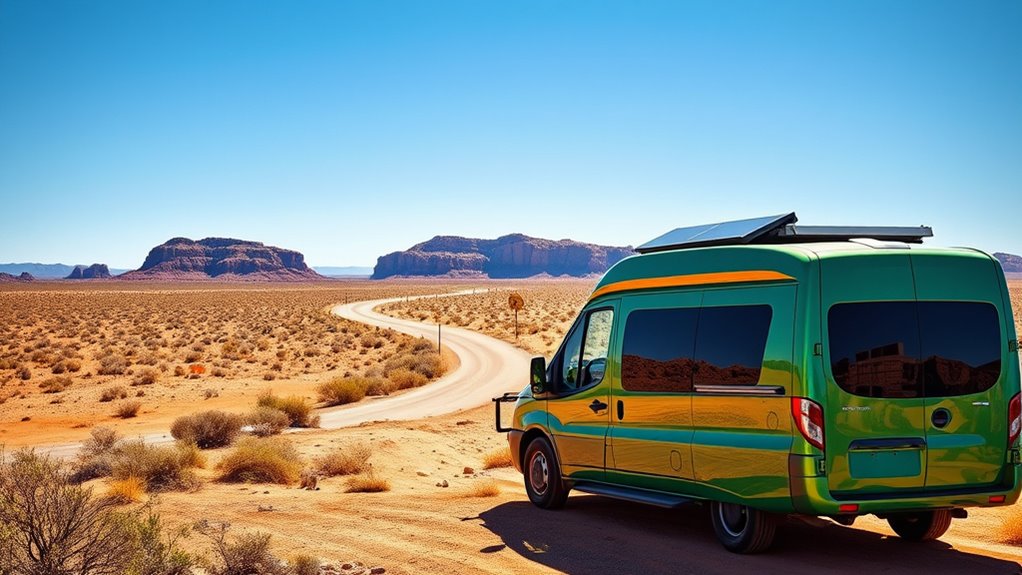Explore Western Australia’s stunning landscapes with electric campervan routes that prioritize sustainable travel. You can journey along the Coral Coast, Pinnacles, Outback, and Wildflower Trails, accessing eco-friendly charging stations, solar setups, and portable power banks. Planning your trip around these options helps reduce your environmental impact while exploring breathtaking scenery. By choosing routes with reliable infrastructure and eco-friendly tips, you’ll have a memorable and responsible adventure—discover how to make it happen as you continue exploring.
Key Takeaways
- Map out routes connecting major charge points in Western Australia, including cities, national parks, and remote areas.
- Prioritize routes with access to solar-powered charging stations and fast-charging infrastructure.
- Incorporate scenic destinations like Coral Coast, Pinnacles, and Outback regions for eco-friendly exploration.
- Plan for portable power options and backup charging solutions in remote or less-developed areas.
- Use route planning tools to optimize travel distances, charging stops, and battery efficiency for a seamless trip.
Exploring the Coral Coast: From Ningaloo to Kalbarri
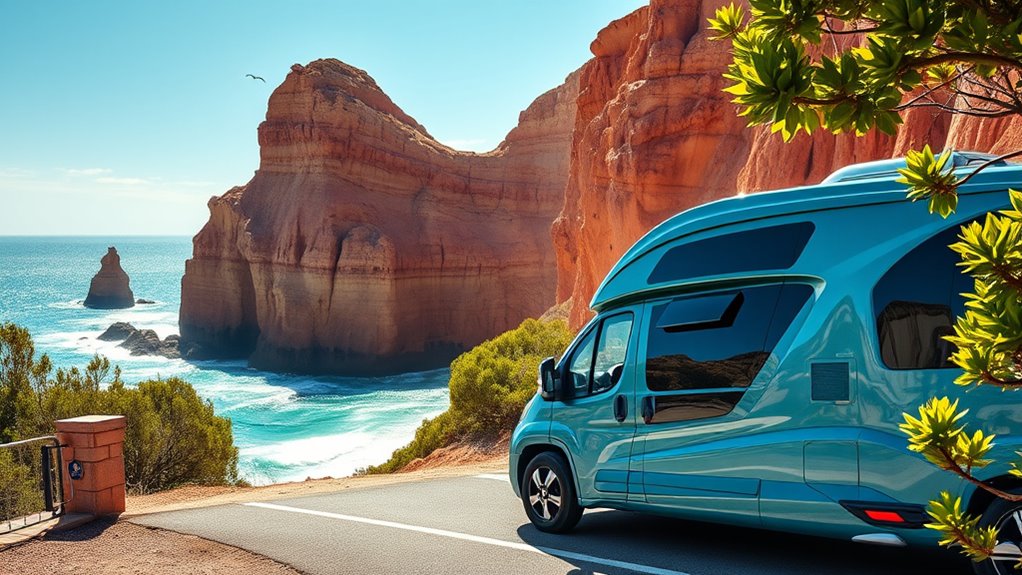
Beginning a journey along the Coral Coast offers an unforgettable experience filled with vibrant reefs, rugged cliffs, and pristine beaches. As you explore, you’ll encounter incredible marine life thriving amidst the colorful coral reefs. Snorkeling or diving reveals a kaleidoscope of fish, turtles, and even manta rays, all part of this underwater paradise. The reefs serve as essential ecosystems, supporting diverse species and creating breathtaking scenery beneath the surface. These ecosystems are vital for the health of the marine environment and biodiversity conservation. Protecting these fragile habitats requires ongoing environmental awareness and community efforts. Additionally, understanding zoning and regulations helps ensure sustainable interactions with these protected areas. The ongoing climate change impact underscores the importance of conservation efforts in maintaining reef health. Along the coast, you’ll also enjoy spectacular vistas of jagged cliffs and golden sands, contrasting beautifully with the lively marine environment below. Whether you’re stopping at Ningaloo or heading toward Kalbarri, the rich marine life and stunning coral reefs promise an immersive adventure that highlights Western Australia’s natural wonders. StrongMocha News Group has highlighted the importance of protecting these ecosystems for future generations.
Navigating the Pinnacles and Nambung National Park
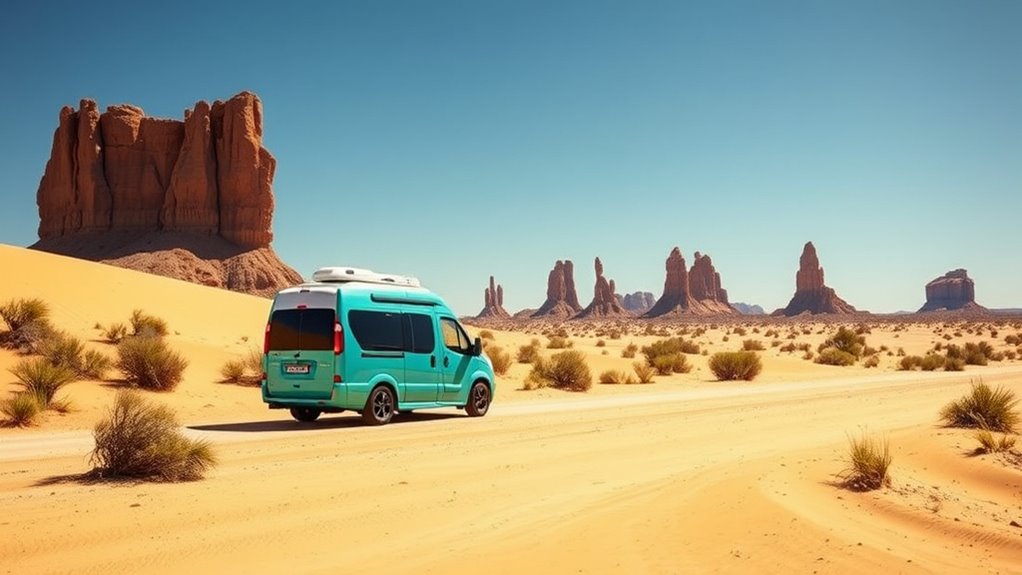
As you approach Nambung National Park, the surreal landscape of the Pinnacles instantly captures your attention, with thousands of limestone spires rising from the desert floor in a striking, otherworldly scene. These formations are best explored by following these steps:
- Drive slowly along the park’s designated roads to fully appreciate the granite formations and intricate shapes.
- Stop at the lookout points for panoramic views of the desert landscapes, where the Pinnacles create a dramatic silhouette.
- Walk the interpretive trails to get closer to the limestone spires and learn about their unique formation process.
- Remember that maintaining a high contrast ratio is essential for viewing these landscapes clearly and vividly, especially in varying lighting conditions.
- To preserve the environment’s integrity, adhere to leave no trace principles and avoid disturbing the natural features as you explore.
- Being mindful of environmental impact helps ensure these natural wonders remain preserved for future visitors. Incorporating sustainable tourism practices can further minimize ecological disturbance.
- Utilizing eco-friendly transportation options, like your electric campervan, further reduces carbon footprint and supports conservation efforts.
Navigating this landscape requires respect for the fragile environment, ensuring your electric campervan remains eco-friendly while you marvel at these natural wonders.
Discovering the Outback of the Pilbara Region
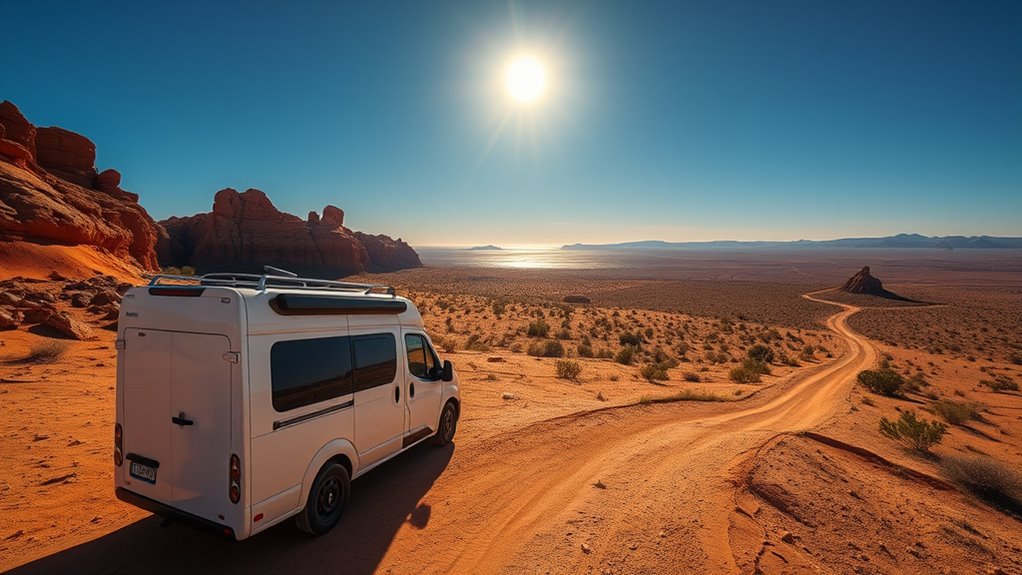
The vast, rugged landscape of the Pilbara region beckons adventurers to explore its ancient red earth and striking rock formations. As you venture into this remote outback, you’ll encounter a rich Indigenous heritage that shapes the area’s cultural identity. Learn about the Dreamtime stories and traditions from local Aboriginal communities. Keep an eye out for resilient desert flora, including spinifex grasses and hardy wattles, which thrive in this harsh environment. These plants not only survive drought conditions but also support native wildlife. The landscape’s raw beauty and deep cultural roots invite you to discover the authentic spirit of the outback, offering a profound connection to the land. Exploring Pilbara’s wilderness reveals a compelling blend of nature, history, and Indigenous culture. Furthermore, understanding the harsh environment can enhance your appreciation of how local flora and fauna adapt to extreme conditions, demonstrating impressive adaption techniques that sustain life in such challenging settings. For instance, many species have developed unique strategies like water conservation and temperature regulation to thrive amid extreme climate conditions. Recognizing the importance of native ecosystems helps in appreciating the delicate balance that sustains life there. Additionally, embracing a positive vibrational outlook can deepen your experience and connection to these powerful landscapes.
Coastal Adventures Along the South West Edge
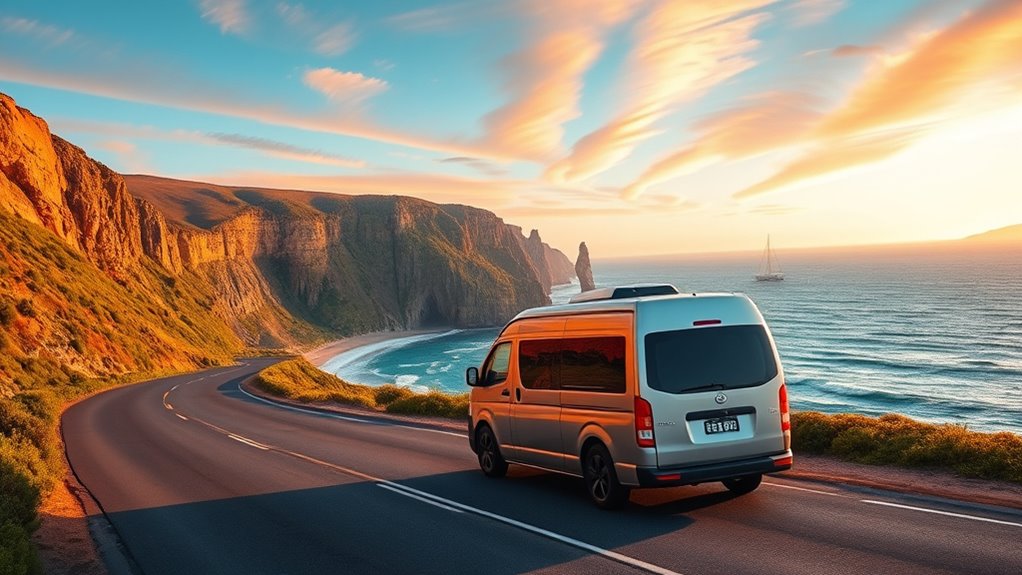
Are you ready to discover the stunning coastline along Western Australia’s south-west edge? Here, you can enjoy vibrant marine wildlife and fascinating coastal geology. As you explore, consider these highlights:
- Spot playful dolphins and migrating whales off the coast during seasonal migrations.
- Visit rugged cliffs and limestone formations shaped by millions of years of coastal erosion.
- Discover hidden beaches where turquoise waters meet sandy shores, perfect for swimming or relaxing.
- Using an electric campervan allows you to explore these scenic spots sustainably, giving you the freedom to immerse yourself in the coastal beauty without leaving a heavy footprint.
Along this route, you’ll witness diverse marine ecosystems and dramatic geological features that tell a story of natural history. Electric campervans let you explore these scenic spots sustainably, giving you the freedom to immerse yourself in the coastal beauty without leaving a heavy footprint. This coastline promises memorable adventures at every turn.
Traversing the Wildflower Trails in the Wheatbelt
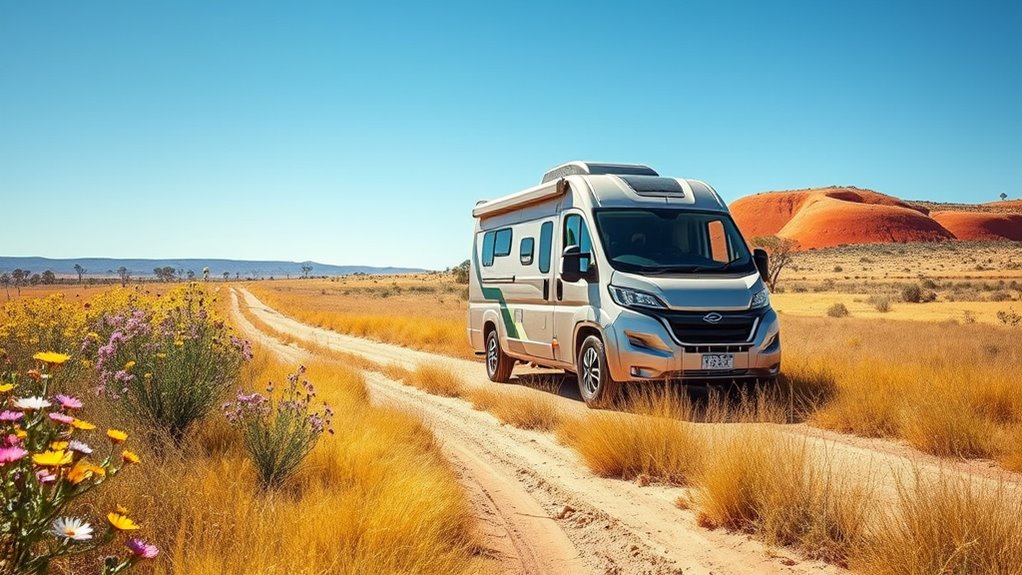
If you want to experience Western Australia’s stunning natural beauty, exploring the Wildflower Trails in the Wheatbelt is a must. As you traverse these trails, you’ll have the chance to practice wildflower identification, recognizing vibrant species that bloom across the region. The wheatbelt ecology supports a diverse range of plants, many of which are endemic and seasonally spectacular. Keep your camera ready and your senses alert—these trails reveal a tapestry of colors and textures unique to this part of Australia. Electric campervans are ideal for this journey, allowing you to enjoy the serenity of the landscape while minimizing your environmental impact. Take your time to explore, learn about the local flora, and immerse yourself in the natural beauty that makes the Wheatbelt a true ecological treasure. Noticing recurring number patterns can also deepen your connection with the environment, providing subtle signs and messages during your adventure, especially when understanding air purification technology and its benefits for outdoor comfort and health. Additionally, using environmentally friendly transportation such as electric campervans enhances your sustainable travel experience while preserving these pristine environments.
Electric Road Trips Through the Kimberley Wilderness
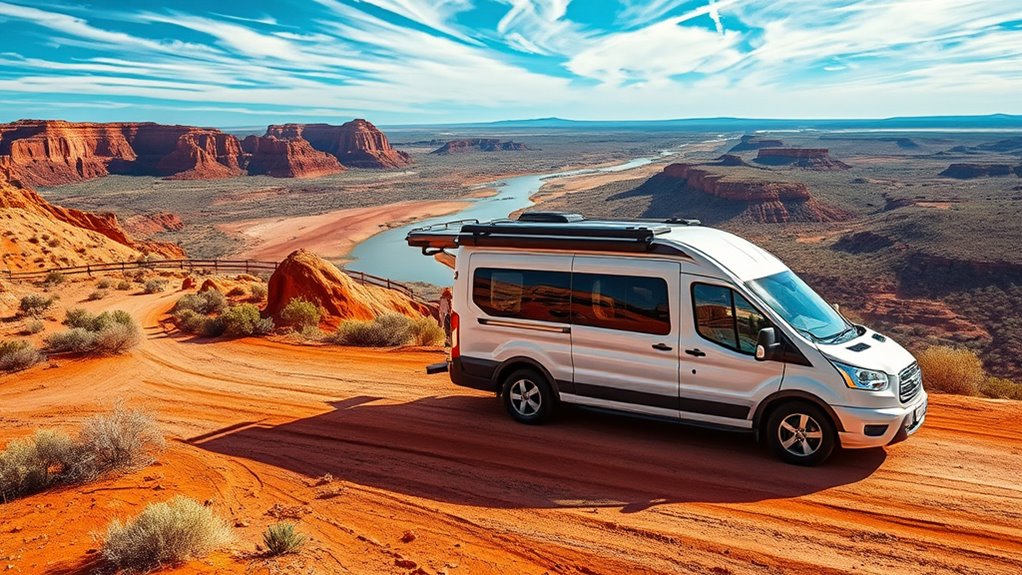
Beginning an electric road trip through the Kimberley Wilderness offers an immersive adventure into one of Australia’s most rugged and breathtaking landscapes. To maximize your journey, focus on three key aspects:
Start your Kimberley adventure with expert tips on solar maintenance, battery monitoring, and portable charging.
- Regular solar panel maintenance guarantees your energy source remains efficient amidst remote conditions.
- Monitoring battery capacity optimization helps you plan charging stops, especially in isolated areas.
- Carrying portable charging options provides backup when solar input is limited by weather or terrain.
Keeping your solar panels clean and free of debris boosts energy generation, while understanding your campervan’s battery capacity allows for smarter trip planning. By maintaining these systems, you’ll enjoy uninterrupted exploration of the Kimberley’s stunning gorges, waterfalls, and ancient landscapes, confident your electric vehicle is performing at its best.
Visiting the Iconic Rottnest Island by Electric Vehicle
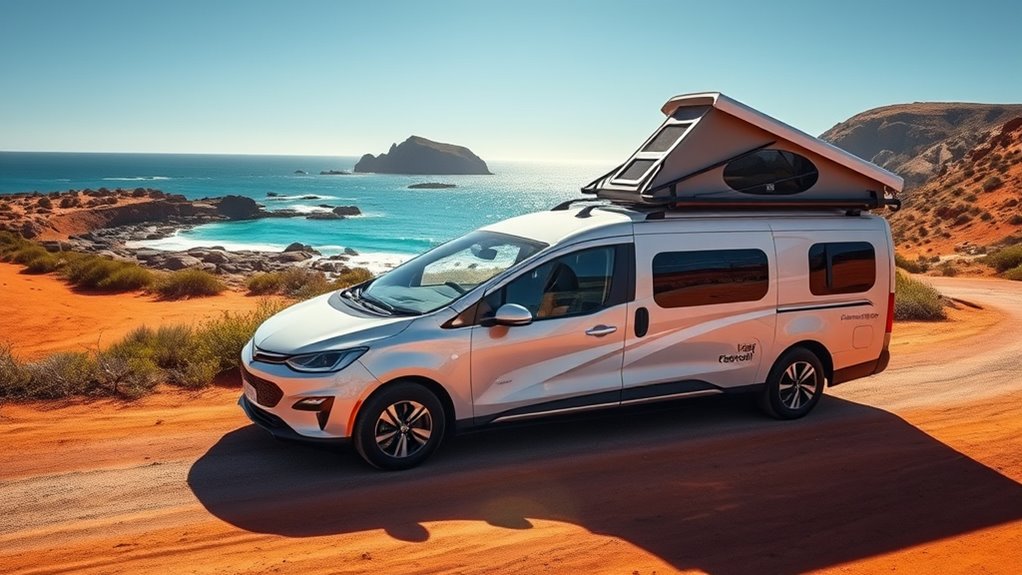
Visiting the iconic Rottnest Island by electric vehicle offers a sustainable and enjoyable way to explore its stunning beaches, historic sites, and unique wildlife. By choosing electric transport, you help protect the island’s delicate ecology and support marine conservation efforts. As you navigate the island’s eco-sensitive areas, your low-emission vehicle minimizes pollution, preserving its pristine environment. Rottnest’s diverse island ecology thrives thanks to conservation initiatives, ensuring the habitats of quokkas and marine life remain undisturbed. Exploring by electric vehicle allows you to experience the island’s natural beauty while reducing your carbon footprint. This eco-friendly approach enhances your visit, making it not only memorable but also aligned with efforts to sustain the island’s ecosystems for future generations.
Sustainable Travel: Charging Infrastructure and Tips
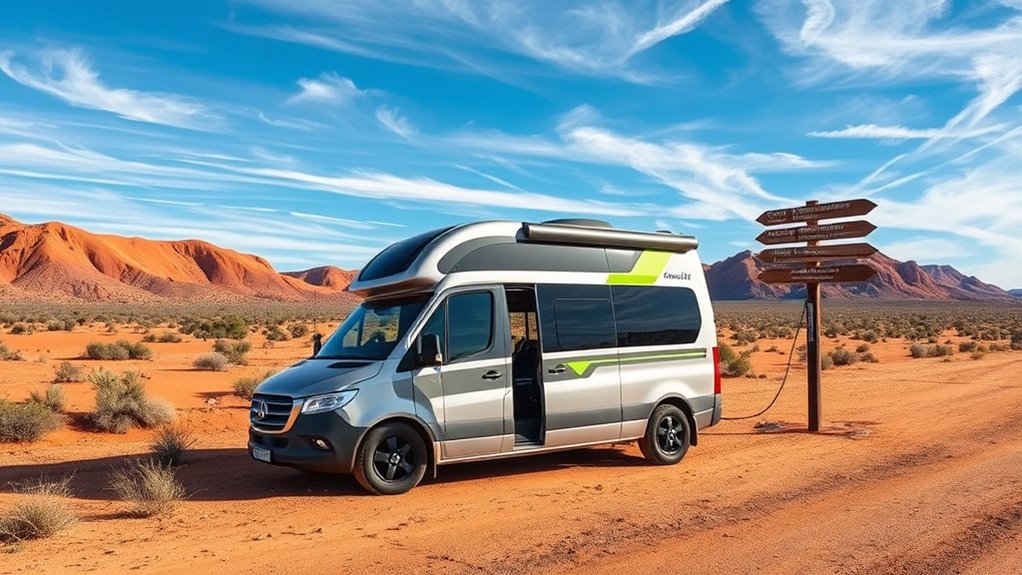
As you plan your trip, it’s important to contemplate the expanding charge point network across Western Australia, making it easier to stay powered up. You can also adopt eco-friendly camping tips to minimize your environmental impact. Together, these strategies help you travel sustainably while enjoying your adventure.
Charge Point Network Expansion
Expanding the charge point network across Western Australia is essential for supporting sustainable travel and ensuring that electric campervans can travel confidently over long distances. As charging stations grow, you’ll benefit from advancements in solar power integration and battery technology, which improve efficiency and reduce reliance on grid power. To maximize your trip, consider these steps:
- Prioritize stations with solar-powered chargers to enhance eco-friendliness and reduce energy costs.
- Use locations with fast-charging capabilities to save time on long journeys.
- Plan routes that align with areas where battery technology allows for extended range, minimizing stops.
A robust network ensures you’ll have reliable access to power, encouraging more sustainable exploration across Western Australia’s vast landscapes.
Eco-Friendly Camping Tips
With a growing network of solar-powered charging stations, you can incorporate eco-friendly practices into your camping routine. Rely on solar power to recharge your campervan, reducing reliance on fossil fuels and lowering your carbon footprint. Be mindful of waste reduction by packing reusable items and avoiding single-use plastics. Practice Leave No Trace principles, disposing of waste responsibly and minimizing impact on the environment. Use eco-friendly cleaning products and conserve water whenever possible. By planning your route around available solar charging stations, you ensure sustainable travel while enjoying Western Australia’s stunning scenery. Small changes like these make a significant difference, helping preserve the natural beauty of the region for future adventurers.
Planning Your Eco-Friendly Western Australia Campervan Journey
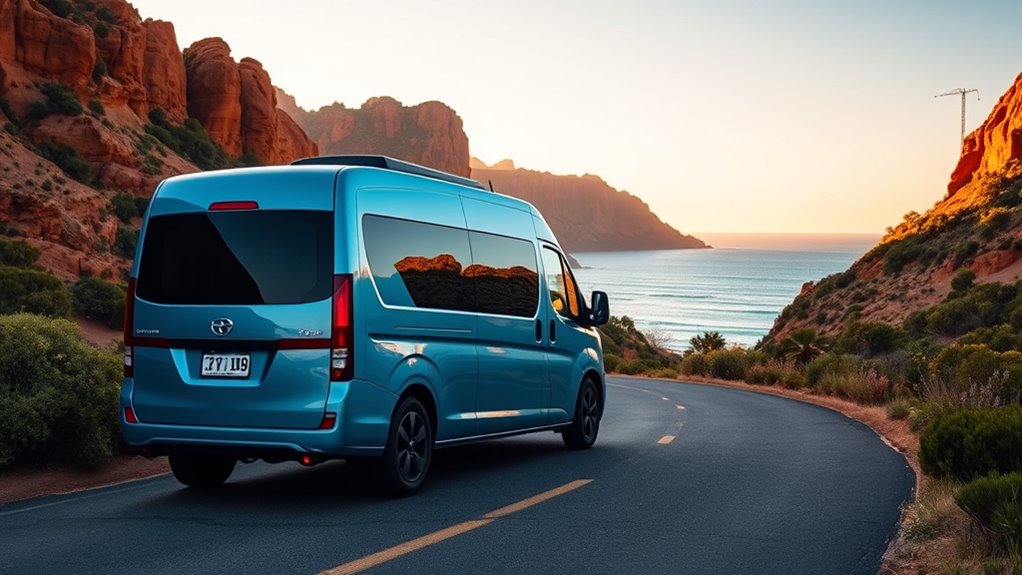
To plan your eco-friendly Western Australia campervan trip, start by exploring charging options along your route and choosing sustainable camping sites. Incorporate eco-friendly travel tips, like reducing waste and conserving energy, to minimize your impact. With careful preparation, you can enjoy a greener adventure across this stunning region.
Charging Infrastructure Options
Planning your eco-friendly Western Australia campervan trip means understanding your charging options along the route. You’ll want reliable ways to top up your battery, such as:
- Charging stations at roadhouses and campgrounds, which are increasing in number across popular routes.
- Solar charging setups on your campervan, harnessing sunlight to extend your range sustainably.
- Portable power banks, allowing you to charge devices or supplement your main battery when access to stations is limited.
Combining these options ensures flexibility and reduces reliance on grid power. Solar charging is especially effective in WA’s sunny climate, while portable power provides backup during remote stretches. Being prepared with multiple charging solutions helps you explore confidently and eco-consciously.
Sustainable Camping Practices
As you explore Western Australia in your campervan, making mindful choices about your camping practices can considerably reduce your environmental impact. Using solar power for lighting and appliances helps cut down on energy consumption and reliance on fossil fuels. Be sure to set up your solar panels efficiently to maximize sunlight collection, ensuring your energy needs are met sustainably. Waste reduction is equally important; carry reusable items like water bottles, utensils, and containers to minimize single-use plastics. Respect local ecosystems by sticking to designated camping areas and avoiding damage to plants or wildlife. Always pack out what you bring in, and dispose of waste responsibly. Small, conscious habits like these profoundly contribute to preserving Western Australia’s natural beauty for future travelers.
Eco-Friendly Travel Tips
Starting on an eco-friendly campervan journey through Western Australia requires intentional planning to minimize your environmental impact. To do so, prioritize practices like using solar power to charge your van’s batteries, reducing reliance on fossil fuels. Additionally, focus on waste reduction by carrying reusable containers and avoiding single-use plastics. Here are three key tips:
- Install solar panels on your campervan to harness renewable energy.
- Pack eco-friendly supplies to cut down on waste.
- Choose eco-conscious campsites that promote sustainability.
Frequently Asked Questions
Are There Any Specific Electric Campervan Rental Companies in Western Australia?
You’re curious about electric campervan companies offering Western Australia rentals. Several providers specialize in eco-friendly options, making your trip sustainable and enjoyable. These companies provide a range of electric campervans suited for different needs, ensuring you can explore Western Australia’s stunning landscapes responsibly. By choosing one of these electric campervan companies, you’ll experience convenient, eco-conscious travel while enjoying the freedom of the open road in Western Australia.
How Long Does It Take to Fully Charge an Electric Campervan in Remote Areas?
Charging an electric campervan in remote areas is like waiting for a slow tide—timing varies. Typically, it takes 4 to 8 hours to fully charge, depending on your vehicle’s battery size and available charging infrastructure. Remote spots often lack fast chargers, so patience is key. Remember, proper battery maintenance and planning ahead make certain your journey stays smooth, preventing unexpected delays in the vast, rugged landscape.
What Safety Measures Should I Consider When Driving an Electric Campervan in the Outback?
When driving an electric campervan in the outback, you should prioritize safety. Be prepared for wildlife encounters by staying alert and avoiding animals at night. Carry essential emergency supplies, like water, a first aid kit, and a charged power bank, to guarantee emergency preparedness. Know your route, and share your plans with someone. Staying cautious and ready helps you enjoy your adventure while keeping safety top of mind.
Are There Any Restrictions on Camping With Electric Campervans in National Parks?
You should check camping restrictions and park regulations before camping in national parks. Many parks have specific rules to protect natural environments, such as designated camping areas and limits on campfire use. Electric campervans may face additional restrictions, like charging station availability or waste disposal policies. Always research the park’s guidelines in advance, follow signs, and respect the environment to guarantee a safe and enjoyable experience.
How Do Weather Conditions Affect Electric Vehicle Range During Coastal Trips?
Weather conditions, like coastal wind and humidity effects, markedly impact your electric vehicle range during coastal trips. Strong coastal winds can increase resistance, causing your campervan to use more energy, while high humidity may reduce battery efficiency. You should plan for these factors by allowing extra charge, driving more smoothly, and avoiding extreme weather when possible. Being aware of weather forecasts helps you optimize your route and maintain sufficient range on your journey.
Conclusion
Setting out on an electric campervan adventure across Western Australia is like painting your own masterpiece on a vast, wild canvas. With each charge and turn, you weave a story of harmony between nature and innovation. Let the open road be your brushstroke, and the endless horizon your backdrop. As you journey through this stunning land, remember—you’re not just exploring, you’re becoming part of its vibrant, sustainable heartbeat.

